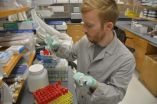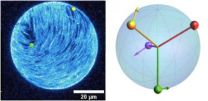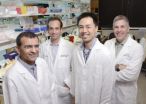(Press-News.org) The sea-grass beds of Long Island's Great South Bay once teemed with shellfish. Clams, scallops and oysters filtered nutrients from the water and flushed money through the local economy. But three decades after the algae that cause brown tides first appeared here, much of the sea grass and the bounty it used to provide is gone.
Spring on eastern Long Island is now marked by dense blooms of Aureococcus anophagefferens, which turn estuaries like Great South Bay the color of mud and crowd out native sea grass and stunt or poison shellfish. For years, researchers have puzzled over Aureococcus's success. How has this microscopic algae adapted so well to coastlines built up with roads and homes? Since surfacing off Long Island in 1985, brown tides now appear as far south as Virginia, and have become a recurring problem off South Africa and northern China.
A new study by researchers at Columbia University's Lamont-Doherty Earth Observatory and Stony Brook University highlights up close the survival skills that have made Aureococcus the bane of fishermen, boaters and real-estate agents. Building on previous mapping of Aureococcus' genome, the study, published in the journal Frontiers in Microbiology this summer, confirms that the genes previously hypothesized to help Aureococcus survive in murky nutrient-rich waters, switch on in conditions typical of estuaries degraded by human activity.
While other photosynthetic algae crave sunlight, Aureococcus can live for days in the dark. When other algae run out of their preferred inorganic nutrients and die, Aureococcus is able to feast on the all-you-can-eat buffet of organic nutrients, sometimes derived from lawn fertilizers and sewage. "They are opportunists," said study lead author Kyle Frischkorn, a graduate student at Lamont-Doherty. "They can exploit the low inorganic nutrient situations that other algae can't, and they continue to grow even when high cell densities shade out light."
Their secret lies in their DNA. In sequencing Aureococcus' genome, researchers discovered it has up to three times as many light-harvesting genes as competing algae. Aureococcus also has the capacity to make enzymes that can break down organic nitrogen and phosphorus when inorganic nutrients run low. Further, its tiny stature—about the size of most bacteria--means it needs fewer resources like nitrogen and phosphorus to compete.
Brown tide usually appears after the spring diatom bloom has depleted estuaries of inorganic nutrients. Aureococcus is able to take over by using alternative organic forms of nitrogen and phosphorus and crowding out remaining competitors as it blooms and blocks out still more light. "We knew Aureococcus could survive and even thrive under adverse conditions," said Sonya Dyhrman, a microbiologist at Lamont-Doherty and a senior author on both studies. "Studying their genes allows us to understand how they are able to do this."
In the Frontiers study, researchers grew a strain of Aureococcus in the lab under conditions of low light, inorganic nitrogen and phosphorus, and also in a control environment of abundant light and inorganic nutrients. They analyzed more than 100 million fragments of RNA, which tell Aureococcus which proteins to make to exploit its environment. Sure enough, Aureococcus turned on its light-harvesting genes in murky water, and its ability to scavenge those alternative organic forms of nitrogen and phosphorus in low inorganic nutrient conditions.
The experiments also turned up a surprise. Aureococcus has developed a way to pump a toxic form of arsenic from its cells. In low-phosphorus conditions, Aureococcus inadvertently draws in arsenate, a form of naturally occurring arsenic that chemically resembles phosphate. To avoid exposure, Aureococcus reduces the arsenate to arsenite, an even more toxic form of arsenic, and pumps it from its cells into the water. The extent to which this toxic byproduct is produced during brown tides, and its effect on the environment and humans is so far unknown.
Researchers suspect that Aureococcus has always lived in the coastal environments where it now thrives. As Long Island's population has boomed, rising nutrient loads from septic systems, aging sewer plants and lawns have seeped into the groundwater, which recharges Long Island estuaries. In these degraded waters, Aureoccocus appears to be uniquely suited to exploit the low light and high organic nutrient levels. "The organism is probably more widespread than we know," said study coauthor Christopher Gobler, a marine biologist at Stony Brook University who led the earlier genome study.
The link between algae blooms and excess nutrients from sewage and fertilizers has been known for decades. Still, towns and cities have been slow to build and upgrade sewer plants, and homeowners and farmers reluctant to change growing practices. Excess manure and fertilizers spread on farms is thought to have fueled the toxic algae bloom that covered Lake Erie in green slime this summer, leaving nearly half a million people in Ohio without water for two days.
On Long Island, the main culprit producing the excess nutrients appears to be faulty septic systems. An estimated 350,000 septic systems on eastern Long Island's South Shore are considered failing, according to a January report by the Suffolk County Executive. Between 1987 and 2001, nitrogen levels in the county's groundwater (which also supplies its drinking water) jumped 40 percent to 200 percent in places. More than half of the nitrogen in Great South Bay has been traced to septic tanks and cesspools, according to a recent study. Algae blooms and excess nitrogen led New York's Department of Environmental Conservation in 2008 to declare the South Shore's 60-mile long estuary impaired.
Local government has begun to act. Suffolk County Executive Steven Bellone recently declared nitrogen "public enemy number one" and is lobbying New York Gov. Andrew Cuomo for state funding to offset the cost of connecting eastern Long Island to a sewage treatment plant.
The economic stakes go beyond the 6,000 jobs that clamming alone once provided in Great South Bay. Tourism pumps nearly $5 billion a year into Long Island's economy, and many worry that brown tide and its ilk will scare away boaters, beachgoers and homebuyers. "Who wants to live in an expensive coastal community where you can't swim in the water and the water's the color of coffee with skim milk?" said Carl LoBue, a marine scientist with the Nature Conservancy.
Continued shoreline growth may signal more brown tides globally. Beyond the nutrient loading that development brings, coastlines hardened with houses and roads leave less room for ocean tides to sweep in and flush out estuaries. Two of the three inlets to Great South Bay opened by Hurricane Sandy have been closed by bulldozers, closing off ocean inflows again. Rising ocean temperatures could further extend Aureococcus' range, though the effects of a warming climate and rising carbon dioxide levels have not yet been studied.
To expand on the Frontiers study, the researchers hope to observe brown tides in the field. "The RNA signals we tracked in the lab could be examined in field populations to see how Aureococcus responds to excess nitrogen and warmer air and sea temperatures," said Dyhrman. "This could help us predict when a brown tide is coming and mitigate its impact."
Against all odds, a few fishermen on Great South Bay are trying to bring back the oysters, which seem more resilient to brown tide than scallops or clams. For four years, retired sound engineer Chuck Westfall has been raising Bluepoint oysters which he markets as "Fire Island Blues" after the barrier island just beyond his oyster beds. Under the great span speeding beachgoers to Robert Moses State Park, Westfall scooped out oysters from several wire cages submerged in knee-deep water. Those exposed to more brown tides were measurably stunted.
Despite the recurring brown tides and other obstacles, what keeps him going, Westfall said, is the potential for success. If he can make it, other shellfishermen will follow and join him in advocating for the bay's protection.
"If we can get enough stakeholders in the bay--people who care about what's going on in the water and not just on top of it--we might be able to induce politicians to make some constructive changes that would help this bay quite a bit," he said.
INFORMATION:
The study was funded by the U.S. National Oceanic and Atmospheric Administration's Center for Sponsored Coastal Ocean Research through its Ecology and Oceanography of Harmful Algal Blooms Program; a National Science Foundation Graduate Research Fellowship; Woods Hole Oceanographic Institution; and the Gordon and Betty Moore Foundation. Other author: Matthew Harke, Stony Brook University.
Like weeds of the sea, 'brown tide' algae exploit nutrient-rich coastlines
Close-up look at genome may lead to new ways to combat harmful blooms
2014-09-05
ELSE PRESS RELEASES FROM THIS DATE:
Past sexual assault triples risk of future assault for college women
2014-09-05
BUFFALO, N.Y. -- Disturbing news for women on college campuses: a new study from the University at Buffalo Research Institute on Addictions (RIA) indicates that female college students who are victims of sexual assault are at a much higher risk of becoming victims again.
In fact, researchers found that college women who experienced severe sexual victimization were three times more likely than their peers to experience severe sexual victimization the following year.
RIA researchers followed nearly 1,000 college women, most age 18 to 21, over a five-year period, studying ...
Breast cancer specialist reports advance in treatment of triple-negative breast cancer
2014-09-05
William M. Sikov, a medical oncologist in the Breast Health Center and associate director for clinical research in the Program in Women's Oncology at Women & Infants Hospital of Rhode Island, served as study chair and lead author for a recently-published major national study that could lead to improvements in outcomes for women with triple-negative breast cancer, an aggressive form of the disease that disproportionately affects younger women.
"Impact of the Addition of Carboplatin and/or Bevacizumab to Neoadjuvant Once-Per-Week Paclitaxel Followed by Dose-Dense Doxorubicin ...
Syracuse University physicists explore biomimetic clocks
2014-09-05
Working with a team of scientists from the Technical University of Munich (TU Munich), Brandeis University, and Leiden University in the Netherlands, M. Cristina Marchetti and Mark Bowick, professors in the Soft Matter Program in the Syracuse University College of Arts and Sciences, have engineered and studied "active vesicles." These purely synthetic, molecularly thin sacs are capable of transforming energy, injected at the microscopic level, into organized, self-sustained motion.
Their findings are the subject of a cover-story in the Sept. 5 issue of Science magazine.
The ...
Thousands of nuclear loci via target enrichment and genome skimming
2014-09-05
The use of next-generation sequencing (NGS) technologies in phylogenetic studies is in a state of continual development and improvement. Though the botanically-inclined have historically focused on markers from the chloroplast genome, the importance of incorporating nuclear data is becoming increasingly evident. Nuclear genes provide not only the potential to resolve relationships between closely related taxa, but also the means to disentangle hybridization and better understand incongruences caused by incomplete lineage sorting and introgression.
By harnessing the power ...
Social support: How to thrive through close relationships
2014-09-05
PITTSBURGH—Close and caring relationships are undeniably linked to health and well-being for all ages. Previous research has shown that individuals with supportive and rewarding relationships have better physical and mental health and lower mortality rates. However, exactly how meaningful relationships affect health has remained less clear.
In a new paper, Carnegie Mellon University's Brooke Feeney and University of California, Santa Barbara's Nancy L. Collins detail specific interpersonal processes that explain how close relationships help individuals thrive. Published ...
Dietary recommendations may be tied to increased greenhouse gas emissions
2014-09-05
ANN ARBOR—If Americans altered their menus to conform to federal dietary recommendations, emissions of heat-trapping greenhouse gases tied to agricultural production could increase significantly, according to a new study by University of Michigan researchers.
Martin Heller and Gregory Keoleian of U-M's Center for Sustainable Systems looked at the greenhouse gas emissions associated with the production of about 100 foods, as well as the potential effects of shifting Americans to a diet recommended by the U.S. Department of Agriculture.
They found that if Americans adopted ...
Disease in a dish approach could aid Huntington's disease discovery
2014-09-05
Creating induced pluripotent stem cells or iPS cells allows researchers to establish "disease in a dish" models of conditions ranging from Alzheimer's disease to diabetes. Scientists at Yerkes National Primate Research Center have now applied the technology to a model of Huntington's disease (HD) in transgenic nonhuman primates, allowing them to conveniently assess the efficacy of potential therapies on neuronal cells in the laboratory.
The results were published in Stem Cell Reports.
"A highlight of our model is that our progenitor cells and neurons developed cellular ...
Novel immunotherapy vaccine decreases recurrence in HER2 positive breast cancer patients
2014-09-05
A new breast cancer vaccine candidate, (GP2), provides further evidence of the potential of immunotherapy in preventing disease recurrence. This is especially the case for high-risk patients when it is combined with a powerful immunotherapy drug. These findings are being presented by The University of Texas MD Anderson Cancer Center at the 2014 American Society of Clinical Oncology's Breast Cancer Symposium in San Francisco.
One of only a few vaccines of its kind in development, GP2 has been shown to be safe and effective for breast cancer patients, reducing recurrence ...
UT Southwestern researchers find new gene mutations for Wilms Tumor
2014-09-05
DALLAS – Sept. 5, 2014 – Researchers at UT Southwestern Medical Center and the Gill Center for Cancer and Blood Disorders at Children's Medical Center, Dallas, have made significant progress in defining new genetic causes of Wilms tumor, a type of kidney cancer found only in children.
Wilms tumor is the most common childhood genitourinary tract cancer and the third most common solid tumor of childhood.
"While most children with Wilms tumor are thankfully cured, those with more aggressive tumors do poorly, and we are increasingly concerned about the long-term adverse ...
Study reveals breast surgery as a definitive and safe treatment for elderly patients
2014-09-05
Singapore, 5 September 2014 – A study conducted by National Cancer Centre Singapore (NCCS) has shown that age per se is not a contraindication to breast cancer surgery, and such surgeries may be safely performed for women aged 80 years and above. Led by Dr Ong Kong Wee, Senior Consultant in the Division of Surgical Oncology, the team consists of Dr Veronique Tan, Consultant, and Dr Lee Chee Meng, Resident Doctor. The study explores the safety of breast cancer surgery in women aged 80 years and above.
A retrospective analysis was performed on 109 elderly women who underwent ...
LAST 30 PRESS RELEASES:
Why nail-biting, procrastination and other self-sabotaging behaviors are rooted in survival instincts
Regional variations in mechanical properties of porcine leptomeninges
Artificial empathy in therapy and healthcare: advancements in interpersonal interaction technologies
Why some brains switch gears more efficiently than others
UVA’s Jundong Li wins ICDM’S 2025 Tao Li Award for data mining, machine learning
UVA’s low-power, high-performance computer power player Mircea Stan earns National Academy of Inventors fellowship
Not playing by the rules: USU researcher explores filamentous algae dynamics in rivers
Do our body clocks influence our risk of dementia?
Anthropologists offer new evidence of bipedalism in long-debated fossil discovery
Safer receipt paper from wood
Dosage-sensitive genes suggest no whole-genome duplications in ancestral angiosperm
First ancient human herpesvirus genomes document their deep history with humans
Why Some Bacteria Survive Antibiotics and How to Stop Them - New study reveals that bacteria can survive antibiotic treatment through two fundamentally different “shutdown modes”
UCLA study links scar healing to dangerous placenta condition
CHANGE-seq-BE finds off-target changes in the genome from base editors
The Journal of Nuclear Medicine Ahead-of-Print Tip Sheet: January 2, 2026
Delayed or absent first dose of measles, mumps, and rubella vaccination
Trends in US preterm birth rates by household income and race and ethnicity
Study identifies potential biomarker linked to progression and brain inflammation in multiple sclerosis
Many mothers in Norway do not show up for postnatal check-ups
Researchers want to find out why quick clay is so unstable
Superradiant spins show teamwork at the quantum scale
Cleveland Clinic Research links tumor bacteria to immunotherapy resistance in head and neck cancer
First Editorial of 2026: Resisting AI slop
Joint ground- and space-based observations reveal Saturn-mass rogue planet
Inheritable genetic variant offers protection against blood cancer risk and progression
Pigs settled Pacific islands alongside early human voyagers
A Coral reef’s daily pulse reshapes microbes in surrounding waters
EAST Tokamak experiments exceed plasma density limit, offering new approach to fusion ignition
Groundbreaking discovery reveals Africa’s oldest cremation pyre and complex ritual practices
[Press-News.org] Like weeds of the sea, 'brown tide' algae exploit nutrient-rich coastlinesClose-up look at genome may lead to new ways to combat harmful blooms




